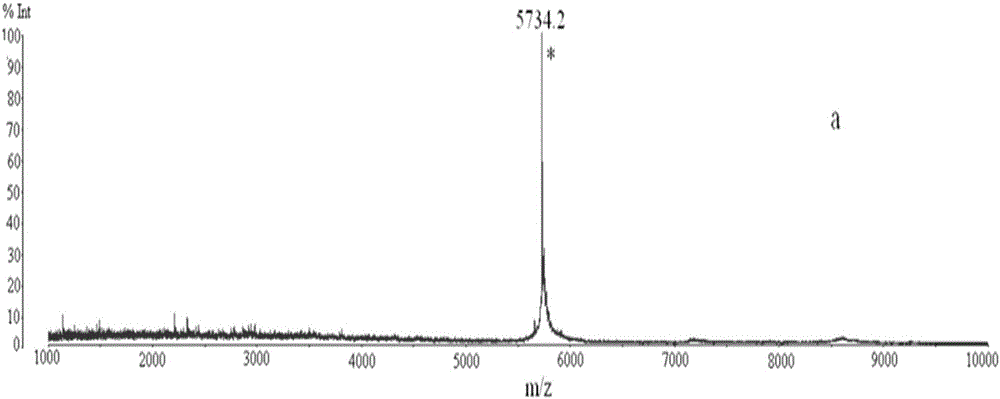Preparation of pancreatic cancer associated polypeptide DAP44 monoclonal antibody and application thereof
A monoclonal antibody, DAP44 technology, applied in the field of anti-tumor, can solve the problems of false positive and false negative, and achieve the effect of good stability and good specific recognition ability
- Summary
- Abstract
- Description
- Claims
- Application Information
AI Technical Summary
Problems solved by technology
Method used
Image
Examples
Embodiment 1
[0022] Example 1 Screening and sequencing of DAP44 protein
[0023] Serum protein samples were collected from 50 patients with pancreatic cancer before operation and on the 5th day after operation, pretreated to remove albumin and other macromolecules, and protein concentration and quantification. The affinity chromatography column filled with concanavalin A is prepared, the sample is directly loaded on the affinity chromatography column (separation chromatography), and the detection wavelength is 280nm. Due to the lack of glycosylation sites, most proteins in serum do not interact with concanavalin A on the affinity column, and only a few protein regions show a strong affinity for concanavalin A. What remains is the N-terminally glycosylated glycoprotein. Protein samples were efficiently separated and collected by size exclusion chromatography, and MALDI-TOF-MS mass spectrometry was used to analyze and compare the results of serum glycoprotein profiles of pancreatic cancer p...
Embodiment 2
[0024] Example 2 Preparation and Screening of Mouse Monoclonal Antibody
[0025] mouse immunization
[0026] The DAP44 antigenic epitope peptide was synthesized by polypeptide solid-phase chemical synthesis, the sequence is shown in SEQ ID NO: 2, and the end was KLH-coupled. Take 8-week-old healthy BALB / Ac mice, mix and emulsify an appropriate amount of KLH-coupled hapten with Freund's complete adjuvant 1:1, and perform multi-point subcutaneous immunization on the back. Two weeks after the first immunization, the DAP44 protein was mixed with Freund's incomplete adjuvant, and the mice were immunized again in the same way as before. Thereafter, the third and fourth booster immunizations were carried out every 3 weeks. Three days after the fourth immunization, blood was collected from the eye veins of the mice, and mice with higher serum ELISA titers were selected for cell fusion.
[0027] Cell fusion, establishment of hybridoma cell lines
[0028] Spleen cells were taken and...
Embodiment 3
[0044] Example 3 Immunohistochemical Application of Monoclonal Antibody
[0045] The two strains of DAP44 antibodies No.2D1C11 and No.1E8H3 screened above were used to make pathological sections according to conventional methods, and immunohistochemical staining was performed on paraffin sections of human pancreatic cancer tissues. The specific method is as follows: baked slices, 68 ° C, 20 minutes, conventional xylene dewaxing, gradient alcohol dehydration; 3% H 2 o 2 Incubate at room temperature for 10 minutes to block inactivation of endogenous peroxidase; antigen retrieval: put the slices in 0.01M citrate buffer (pH 6.0), boil for 5-10 minutes, and cool naturally; normal goat serum working solution is sealed at room temperature 30min, pour it out without washing; add primary antibody (1:300) and incubate overnight at 4°C refrigerator, wash 3 times with PBS × 5min; add biotin-labeled secondary antibody dropwise, incubate at 37°C for 30min, wash 3 times with PBS × 5min; dro...
PUM
 Login to View More
Login to View More Abstract
Description
Claims
Application Information
 Login to View More
Login to View More - R&D
- Intellectual Property
- Life Sciences
- Materials
- Tech Scout
- Unparalleled Data Quality
- Higher Quality Content
- 60% Fewer Hallucinations
Browse by: Latest US Patents, China's latest patents, Technical Efficacy Thesaurus, Application Domain, Technology Topic, Popular Technical Reports.
© 2025 PatSnap. All rights reserved.Legal|Privacy policy|Modern Slavery Act Transparency Statement|Sitemap|About US| Contact US: help@patsnap.com



